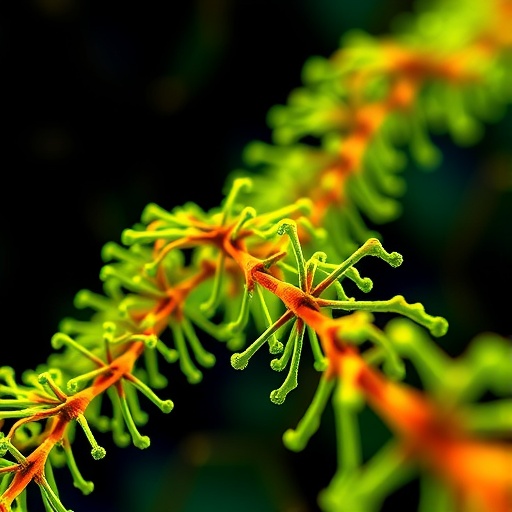
Rice University researchers are pioneering a groundbreaking approach to computing by harnessing the inherent capabilities of living cells. Spearheaded by biosciences professor Matthew Bennett, a recently awarded $1.99 million grant from the National Science Foundation will fund a four-year investigation into the engineering of bacterial consortia as biological computing systems. This visionary project, involving collaborative efforts from experts across Rice University and the University of Houston, seeks to create computing platforms fundamentally different from today’s silicon-based hardware, instead building complex computational networks directly from living microbial cells.
At the heart of this research lies the integration of microbial sensing and communication with electronic networks. Conventional computers rely on silicon chips and electronic circuits to process information, but biological systems have evolved millions of years to excel in environmental sensing, communication, and adaptation. By linking bacterial cells into living networks that can process chemical inputs and relay signals electronically, Bennett and his team aim to develop a new generation of biohybrid computing devices capable of operating in environments that traditional machines find challenging.
Synthetic biology underpins this ambitious effort, treating microbes not merely as organisms but as programmable information processors. Unlike binary-based electronic logic, these living cells can engage in parallel processing, responding to diverse stimuli through intricate biochemical signaling pathways. The team is particularly interested in microbial consortia—communities of multiple bacterial species that interact synergistically—to produce computational behaviors resembling those of distributed computing architectures. Such systems have the potential to learn, adapt, and evolve dynamically within fluctuating real-world environments.
One of the project’s primary goals is to engineer microbial systems that can recognize complex chemical patterns. These patterns include biomarkers indicative of diseases or environmental contaminants. Through interfacing bacterial communication with electronic readouts, these bio-computers could function as smart biosensors, continuously monitoring specific molecular signatures and reporting their findings with high sensitivity and specificity. This approach could revolutionize medical diagnostics by enabling early detection of diseases or environmental hazards through compact, living sensing devices.
The research also focuses on maintaining long-term microbial viability and computational reliability. Continuous culture systems will be developed to sustain the activity of engineered bacterial communities, ensuring stable function over extended periods. Moreover, the interface between living cells and electronics allows for real-time tuning and refinement of responses through feedback mechanisms. This hybridization represents a novel paradigm where biological and artificial systems operate synergistically rather than in isolation.
Crucial to the endeavor is the exploration of cellular memory and learning within microbial consortia. Cellular memory refers to the ability of bacteria to retain information from past stimuli and modify their behavior accordingly. By manipulating genetic circuits and signaling pathways, the researchers hope to instill a form of biological learning, enabling these living computers to improve their pattern recognition capabilities over time. This capacity for adaptive computation far exceeds the static function of current digital hardware.
Beyond the technical innovations, Bennett’s team is deeply invested in addressing the broader ethical, legal, and societal implications of programmable living computers. The fusion of biology and computation raises profound questions about safety, regulation, and public acceptance. The project will engage with policy experts and the public to evaluate regulatory frameworks and potential concerns associated with deploying living computational devices outside laboratory settings, such as in healthcare or environmental monitoring.
The potential applications of such living computing systems are vast and transformative. In medicine, they could offer continuous, in situ diagnostics that outperform traditional laboratory tests in speed and contextual understanding. In environmental science, living computers may enable real-time, on-site detection of pollutants and toxins, facilitating immediate responses to contamination. Moreover, these systems could be scaled and adapted to unprecedented computational tasks currently inaccessible to silicon-based machines.
On a fundamental level, this research challenges long-standing dichotomies between the living and the mechanical. By demonstrating that biological cells can be engineered into functional computing platforms, Bennett’s team blurs the line between organism and machine, opening new frontiers in both computational science and synthetic biology. This convergence foreshadows a future where computational power is no longer confined to physical chips but distributed across networks of living cells.
Microbes possess remarkable natural capabilities for sensing and communication, often involving chemical gradients, electrical signaling, and quorum sensing—a mechanism by which bacteria coordinate behavior based on population density. By co-opting and rewriting these intrinsic pathways, the research aims to construct living circuits capable of performing logical operations and complex signal processing. Such networks could one day rival or surpass traditional electronic systems in adaptability, resilience, and energy efficiency.
In practical terms, the project plans to develop prototype platforms demonstrating microbial-electronic hybrid computation. These will involve custom-designed bioreactors and electronic interfaces to test processing speed, accuracy, and robustness under varying conditions. The iterative design process will leverage advances in genetic engineering, microfluidics, and materials science to optimize the bio-computing systems’ performance.
Ultimately, the success of this initiative could usher in a new era of computing technology—one that harnesses the self-organizing power of biology and the precision of electronics in concert. The implications extend beyond technology, potentially inspiring reconsiderations of computation, intelligence, and life itself. As Bennett articulates, “By integrating biology with electronics, we hope to create a new class of computing platforms that can adapt, learn and respond to their environments,” heralding an extraordinary fusion of the organic and the engineered.
Subject of Research: Engineering bacterial consortia for biological computing systems integrating microbial sensing with electronic networks.
Article Title: Rice University Advances Living Computers: Engineering Bacterial Consortia as Next-Gen Computational Platforms
Web References:
https://profiles.rice.edu/faculty/matthew-bennett
https://www.bakerinstitute.org/expert/kirstin-rw-matthews
https://profiles.rice.edu/faculty/caroline-ajo-franklin
https://profiles.rice.edu/faculty/anastasios-kyrillidis
Image Credits: Photo by Jeff Fitlow/Rice University.
Keywords: Systems biology, Microbial signaling, Computer science, Medical diagnosis, Environmental monitoring, Microorganisms
Tags: alternative computing platformsbacterial networks for computationbiohybrid computing devicesbiological computing systemselectronic communication networksenvironmental sensing with microbesliving cells in computingmicrobial consortia engineeringNSF-funded bioscience projectsprogrammable microbial information processorsRice University research innovationssynthetic biology applications




